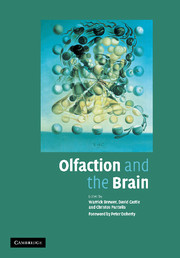Book contents
- Frontmatter
- Contents
- Foreword
- Preface
- List of Contributors
- Section I Neurology, Neurophysiology and Neuropsychology: Olfactory Clues to Brain Development and Disorder
- 1 Structure and Function of the Olfactory System
- 2 Olfaction and the Temporal Lobes
- 3 Role of the Insula in Smell and Disgust
- 4 Olfaction and Memory
- 5 Olfactory Neurogenesis: A Window on Brain Development
- 6 Olfactory Processing and Brain Maturation
- 7 Probes of Behaviour Regulation: Olfactory Models in Addiction
- Section II Social Functioning: Role of Evolution, Genetics and Gender
- Section III Assessment and Disorders of Olfaction
- Index
- Plate section
- References
1 - Structure and Function of the Olfactory System
from Section I - Neurology, Neurophysiology and Neuropsychology: Olfactory Clues to Brain Development and Disorder
Published online by Cambridge University Press: 17 August 2009
- Frontmatter
- Contents
- Foreword
- Preface
- List of Contributors
- Section I Neurology, Neurophysiology and Neuropsychology: Olfactory Clues to Brain Development and Disorder
- 1 Structure and Function of the Olfactory System
- 2 Olfaction and the Temporal Lobes
- 3 Role of the Insula in Smell and Disgust
- 4 Olfaction and Memory
- 5 Olfactory Neurogenesis: A Window on Brain Development
- 6 Olfactory Processing and Brain Maturation
- 7 Probes of Behaviour Regulation: Olfactory Models in Addiction
- Section II Social Functioning: Role of Evolution, Genetics and Gender
- Section III Assessment and Disorders of Olfaction
- Index
- Plate section
- References
Summary
Introduction
The olfactory system comprises a sensory organ (the olfactory epithelium) and specific olfactory brain regions, the first of which is the olfactory bulb. The perception of odours poses interesting and different problems for the nervous system – problems unique to the odorous world. The first of these is that there is no single dimension that relates stimulus to sensation. Vision and hearing are stimulated by predictable variations in frequencies of light and sound; touch by variations in frequencies of pressure on the skin. Odorant molecules have no obvious connections with each other except that they are odorous – that is, they evoke sensations in the olfactory system. The second unique attribute of the olfactory system is that there seems to be no limit to the number of odorous molecules that can be detected and described. Vision, hearing and touch all operate within limited spectra of light, sound and pressure, predictable spectra to which the systems have evolved. Odorous molecules are mainly limited to molecules of 200 to 400 mW but within that range, there are essentially an infinite number of odorous molecules. The molecular structures are highly variable and no individual or group of individuals has been exposed to all of the range, or possibly even the majority of the range.
How, then, could a system evolve to detect and respond to such an open ended set of stimuli?
Keywords
- Type
- Chapter
- Information
- Olfaction and the Brain , pp. 3 - 27Publisher: Cambridge University PressPrint publication year: 2006
References
- 13
- Cited by



